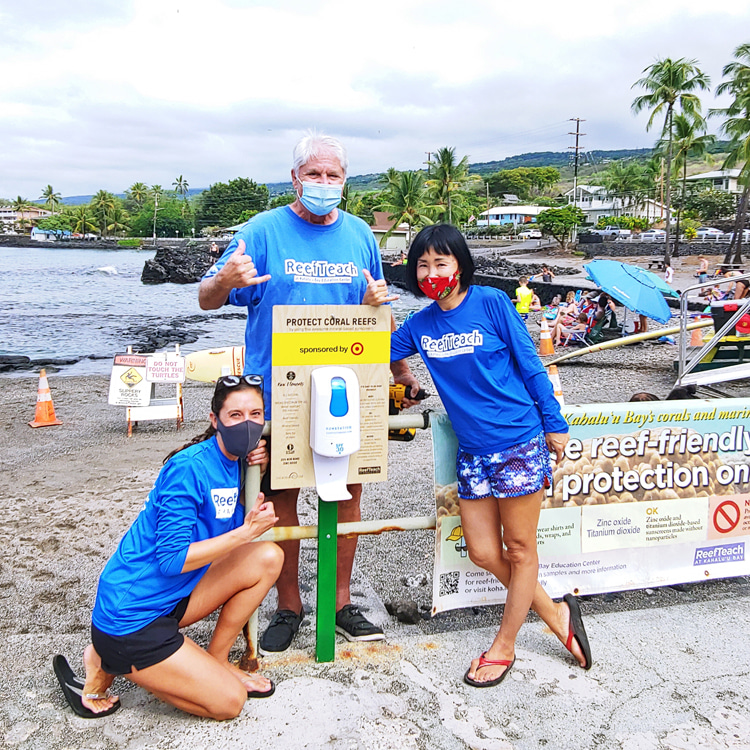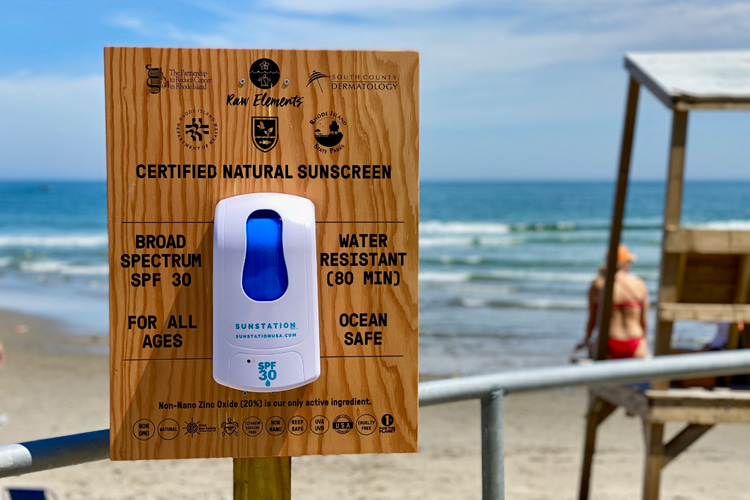The Hawaii's ban on the sale of sunscreens containing two chemicals harmful to coral reef ecosystems is now in effect.
As a result, a popular snorkeling spot on Hawaii Island is providing beachgoers with easy access to a sunscreen option that's kinder to marine life - and possibly their own health.
The Kohala Center, in partnership with Raw Elements USA and Target, launched a public reef-friendly sunscreen dispenser program at Kahaluu Beach Park on January 23, 2021.
The program launches as Hawaii's statewide ban takes effect on the sale of sunscreens containing the active ingredients oxybenzone and octinoxate.
Hawaii was the first in the world to issue such a ban, prompting many governments around the globe to follow suit.
The dispenser idea has even caught on in the Hawaii State Legislature, with several lawmakers planning to submit bills that would establish a pilot program to install sunscreen dispensers at four popular Hawaii beaches.
The goal is to provide reef-friendly sunscreen samples to visitors and education on the harmful effects of oxybenzone and octinoxate on marine ecosystems.

Harmful Ingredients
Research confirms that active ingredients found in many common sunscreens, such as oxybenzone, octinoxate, and octocrylene, are harmful to the health of coral reef ecosystems.
These chemicals damage coral DNA and larvae, contribute to coral bleaching and affect the health of algae, fish, shellfish, urchins, and marine mammals.
Moreover, US Food and Drug Administration (FDA) research found that these chemicals, when used topically as directed, are absorbed through the skin into the bloodstream.
Further research is needed to determine potential health effects and what levels of absorption are considered safe.
To date, the FDA has designated only two sunscreen ingredients as "GRASE" (generally safe and effective): mineral UV filters, zinc oxide, and titanium dioxide.
"Recent science has shown that many of these other sunscreen ingredients can also be harmful to marine life, such as octocrylene, homosalate, and octisalate," said Dr. Craig Downs, a toxicologist and executive director of Haereticus Environmental Laboratory.
"These chemicals are similar to oxybenzone in their toxic action in that they can harm photosynthesis, they can potentially cause 'birth defects' in fish as well as humans, and are endocrine disruptors."
Two touch-free stations at the bay safely dispense samples of Raw Elements' Certified Natural Sunscreen.
Raw Elements uses non-nano zinc oxide, a natural mineral, as its only active ingredient.
Non-nano zinc oxide is a safer, natural, and effective ingredient that protects humans from the sun without threatening or damaging coral reefs and marine life.
Positive Results at Kahaluu Bay
A popular place for residents and visitors alike, Kahaluu Bay's vibrant coral reef ecosystem was being compromised by high volumes of beachgoers and some of the highest levels of oxybenzone measured anywhere in the world.
In 2018, The Kohala Center launched a reef-friendly sun protection campaign through its on-site Kahaluu Bay Education Center, offering sunscreen swaps, reef-friendly sunscreen samples, educational pamphlets and programs, and more.
Water samples taken at the time revealed oxybenzone levels as high as 2,947 parts per billion: 262 times greater than EPA's high-risk threshold.
A year and a half later, oxybenzone levels in the bay had dropped between 93 and 100 percent across multiple test sites.
"What these results show is that community stewardship and education work," said Cindi Punihaole, Kahaluu Bay Education Center program director.
"We have meaningful conversations with visitors every day to let them know about the damaging effects chemical sunscreens, and physical contact with corals can have on our vulnerable reefs."
Raw Elements has been at the forefront of the reef- and human-safe sunscreen movement for a decade and is also a 1% For The Planet business member and founder of World Reef Day.
"We can't express enough how the work of Aunty Cindi and her team at Kahaluu Bay is the gold standard model to replicate and activate positive change," stated Brian Guadagno, Raw Elements USA Founder.
"Our public sunscreen dispenser programs are highly effective, and we are grateful to The Kohala Center and Target for bringing this all together to help protect Kahaluu Bay and its visitors."
Spreading Mineral-Based Sunscreens
Making this initiative possible through grant support is retail giant Target, with its Kailua-Kona store featuring dedicated displays promoting mineral-based sunscreens.
"We're proud to sponsor the reef-friendly sunscreen dispenser program at Kahaluu Bay," said Mike Gustafson, team leader of Target's Kona location.
"It is important that we protect our fragile coral reef."
In support of this initiative, Target will be introducing Raw Elements sunscreen in select stores across the United States, including Hawaii.
"Our campaign, and the subsequent reduction in visitors due to Covid-19, have contributed to significant improvement in water quality, and the bay has had a chance to begin healing," Punihaole said.
"We want to maintain these gains, so reinforcing the message and helping people make reef-friendly choices is even more important today."
"These dispensers are an important tool in introducing visitors to the bay to safe, healthy, and effective alternatives, both for the environment and for themselves."
